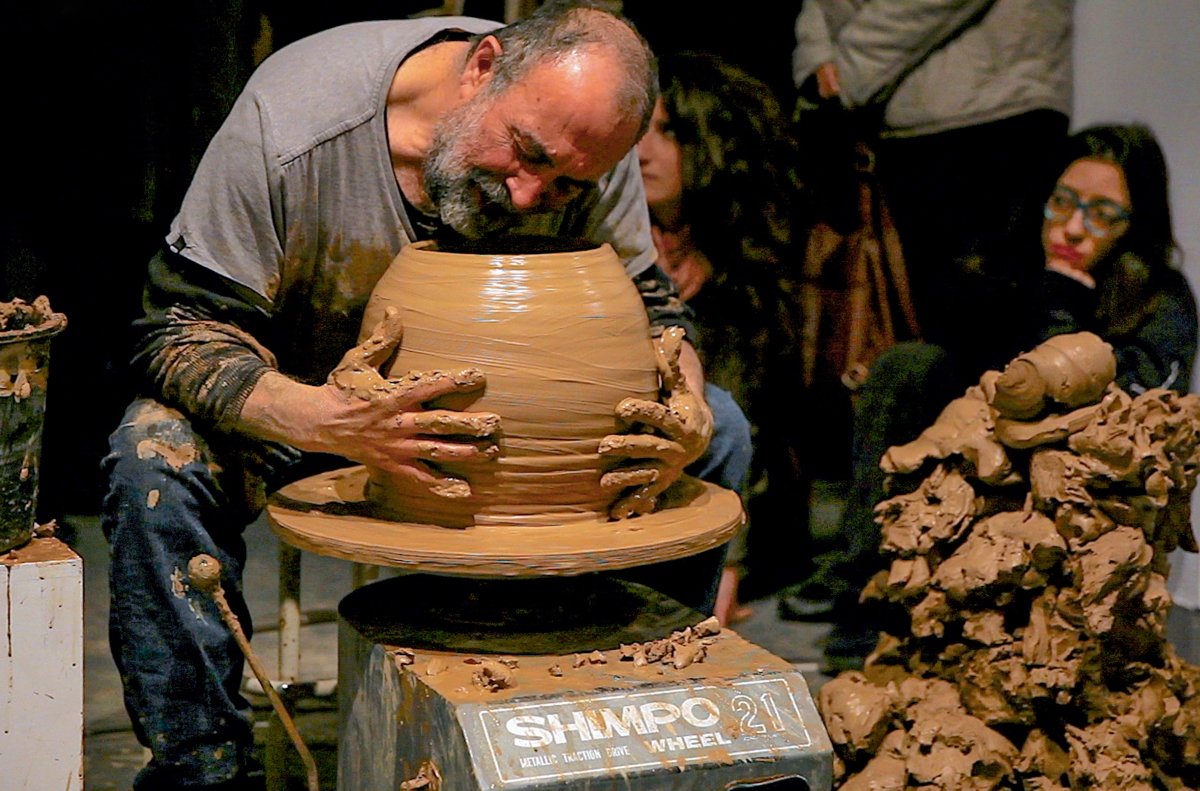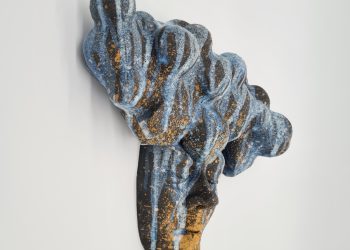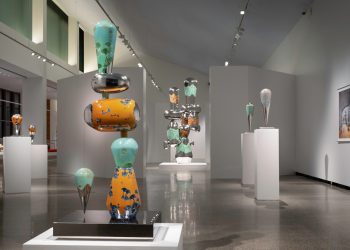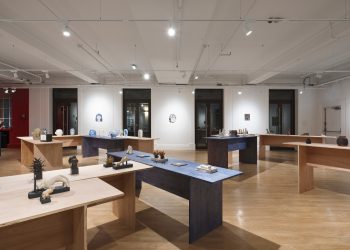Hector Mavridis is an artist who lives and works in Thessaloniki, Greece. Born in Melbourne, Australia, he moved to Greece in 1969. Between 1979 and 1988 he studied Linguistics and Ceramics at Northeastern Illinois University, Chicago.
Over the years, he has participated in dozens of exhibitions around the world and has created numerous performances in Greece, Germany, Israel, Spain, France, North Macedonia, and the United States. Since 1991 he has been teaching ceramics in his pottery studio, The Almond Grove.
Back to Earth (dir. Chryssa Tzelepi, Akis Kersanidis, 2021), a documentary movie about his work, has won the Greek Association of Film Critics Award at the 23rd Thessaloniki Documentary Festival.
Theoretical and attitudinal changes towards ceramic discourse and practice brought about changes in how I view my materials. Thus, clay, glaze, air, water, and fire, from materials that co-existed in the production of a ceramic object, became separate entities, each one with its character, qualities, and language. Co-existence was of no importance. This ‘new’ Ceramics language code released other aesthetic events, gestural acts, and conceptual and experimentation realizations or proposals.
Visit Hector Mavridis’ website and Instagram page.
Featured work
Selected works, 1994-2021

Hector Mavridis: Connecting the Disconnected
Article by Luke Prodromou with an introduction by Areti Leopoulou
Sometimes a misunderstanding allows us to perceive more than we would initially realize. When I met Hector Mavridis, I was convinced he was a performance artist and in fact a conceptual one, working somewhere between land art and Arte Povera areas.
It took me a while to find out there is a common denominator to all of his performances; focusing on the multidisciplinary character of his work, it is clear that his case is very rare and sui generis. Ceramics is indeed the springboard of Mavridis oeuvre; through that, not only does he work on the process of artistic creation, but he pushes further the limits of every field, functioning as a free-of-artistic-stereotypes creator. As a ceramic artist, he leaves the world of fired clay behind, extending the limits that define and confine ceramics.
Thus, one can see ceramics, with plenty of aesthetic and technical experimentations. Gestural imprints of unfired or partly fired clay, metal oxides, water and fire on paper or plywood, which he considers a paradigm for/of ceramic paintings.
Sculptural installations, public performances and interventions not only create artistic objects and situations but most importantly cause an artistic discourse about the unlimited versions, stories and identities of ceramics and pottery.
I consider myself lucky to have met such an artist, as he actually introduced me to artistic ways and manners that always co-exist with fine art and primal concepts, highlighting, most of all, the process of creating something out of earth and soil; just like life itself.
Connecting the Disconnected
The distant image of Hector Mavridis, on the empty horizon, a tiny figure walking alone in a deserted field, captures the individual dimension of his work; he is walking purposefully towards a single tree in the middle of the picture, as if on his way to an important encounter; the tree is the meeting point of the vast sky, the field, and the artist. And the field looks empty but in fact contains countless clods of clay.
Hector will methodically choose clods of the right shape and size, and take them back to his studio where he will transform the shapeless lumps of earth using the archetypal elements of water, air, and fire.
These are scenes from the 2021 award-winning documentary on the life and work of Hector Mavridis: Back to Earth*
The title captures only one dimension of his work, as we shall see, for the earth is not the final or exclusive location of his work but industrial market society, where art itself often becomes another consumer product.
In the film, we learn that Mavridis’ projects may begin with the lone artist confronting basic elements of nature but his aims and procedures are profoundly communal: his art begins and goes back to the earth, and often involves his viewers, members of society, people going about their everyday chores, in enacting the art-work and connecting it with wider social issues, the nature of labor, industry and the role of the artist in a modern market economy.
The clods, an ongoing project, show the inception of the work, going back to Mavridis’ memories of his father taking his son, the future ceramist, with him as he worked in the fields. The clods, glazed will, eventually, go back to the fields, ‘back to earth’, to become an ephemeral landscape exhibition for the local farmers, farm-workers and passers-by. Hector’s role is that of collaborator with, not appropriator of, his materials. The clods, glazed, will return to the field where they were discovered, they are part of – not apart from – the soil which gave them birth.
The artist’s work is integrated with and respectful of nature but it also explores the nature of everyday labor, enriching it with beauty and ideological significance.
The first time I saw Hector Mavridis demonstrating his art was in 2007; he was standing in the port area of Thessaloniki engaged in a mundane act of labor: numbering bricks.
The performance had begun with a truck placing two pallets of unfired bricks on the ground in the port area, one pile of bricks was leather-hard and the other was bone-dry – both are the same type of brick used in the construction of nearby buildings in the city’s port area.
After numbering the bricks, Mavridis carried them with increasing effort to another pallet – I later realized that this foregrounding of strenuous labor was deliberate and would be reflected years later in the performance
‘’Shovelling earth from one place to another’’, in Wuppertal, Germany (2016), which focussed on manual labor as an archetypal gesture; in this performance as in others (Anachronism, 1995) Mavridis dignifies the hardship of the ’unseen’ worker by attributing performative aspects to his manual activity,
The visitors to the brick performance (‘Uf!’) were not passive spectators: they became active participants in this ‘laborious’ process, sharing in the sheer effort and the toil of work by transferring the bricks from one pallet to the other; thus, they acquire the status of ‘sponsors of labor’.
When the phrase ‘SPONSOR OF LABOUR” is stamped on the brick with the participants’ name inscribed on it, the visitors to the Biennale then disperse to return home, ordinary citizens, taking with them ‘their’ brick; the static material object, Mavridis argues, becomes dynamic, as it enters the public domain and is diffused into the life of the city.
Compare the way, the humble clods, inert in the earth, ‘get up’ and move from the earth to the studio and back to the earth again; the clods become diffused into the life of the soil and the workers on the land.
The inert objects become carriers of ideas. In both ‘works’, landscape art and performance, we are witnessing the transformation of tedious repetitive action, typical both of everyday routine and industrial labor, into something rich and strange; it is a process of defamiliarising the familiar and exploring the nature of work and art in a post-industrial society.
The linguistically-trained Mavridis might see his work as taking the language or syntax of mundane materials (clods, bricks, soil) and repeated experience (labor, routine, the everyday) and through a process of transformation, building a new artistic semantics which both gratifies the eye and stimulates the mind into questioning the role of art in a consumer society.
Hector Mavridis creates extraordinary effects out of ordinary means and materials: bricks, soil, clay, clods; with the help of the elements of earth, water, air and fire he ‘distances’ the everyday and routine, making it into something ‘unfamiliar’.
My final example of Hector Mavridis’ work pulls these strands of his work together in the most powerful way: The Visceral Humming of the Spiral
The Visceral Humming of the Spiral
Labour as work and labor in birth are strikingly evident and integrated into this most complete and complex of Mavridis’ performances.
On the stage, there is a lump of amorphous clay of almost human proportions – standing alone, surrounded by spectators who are waiting in silence. The solid clay is roughly conical in shape.
In the midst of the audience, there is a pedestal with an exhibit, covered by plexiglass: it is a clay pot freshly made. A man dressed in working clothes goes up to the pedestal, lifts the plexiglass, and takes the pot in his hands. He emerges from the crowd and walks over the stage to the big lump of clay; the man chucks the pot on top of the clay; the well-shaped pot, as it lands on the apex of the conical lump, immediately collapses into a shapeless mass, making the clay look vaguely like a human figure. Is that a head? A bust? A belly? It’s hard to tell.
The uncertainty will be constant throughout this performance and our role will be not only to look on but to see in different ways, to fill out the emerging, indefinite forms with our imagination.
The man sets to work; he takes water from a bucket and splashes the clay, caressing it, making the soft texture of the material shiny.
With repetitive, visible, physical effort, he begins to carve chunks out of the responsive bulk of clay, with his hands, making crude indentations in the round surface of the raw brown material. He drops the clods of clay carelessly on the floor next to him.
As he continues, the effort, breathy and muscular, reduces the mass of clay, distorts it moment by moment, so it changes appearance. We witness two parallel transformations: the original raw material as it gets smaller and smaller and the gradually growing mass of ragged clods as they rise from the ground; as the one shrinks, the other grows.
The man, his worker’s clothes increasingly splattered with clay, holds the emerging figure really close to his body as if hugging it.
The visual performance of the man-turned-sculptor is now complicated by the sound of a distant electronic humming coming from one direction and a human voice coming from another direction– the three actions, the carving of the clay, the electronic music, and the human voice, come together, merge, diverge and converge again; there are no recognizable melodies or words, as there is no recognizable sculpture. It is sound almost becoming a melody, words almost making meaning, clay in the processing of becoming something.
The listeners, still and silent, are free to make their own meaning: the sounds, machine-made and human, add complexity to the visual performance of the sculptor.
The visual and the acoustic begin to interact, to merge and clash and seem to be engaging in dialogue, the discord striving to become discourse. The sounds made by Anat Pick and Savina Yiannatou** the vocal artists, are phonetically raw, hissing, scraping, sighing but, at moments, one can almost detect meaningful sounds striving to escape from the amorphous acoustic material, as the voice-poet responds to and interacts with Hector Mavridis, the shaper-of-clay.
In the background to this dialogue between potter, poet and vocalist is the steady almost unchanging, unearthly sound of the electronic music, performed by Costis Drygianakis; the music follows the potter’s rhythm, the twists and turns of the action as it unfolds.
Suddenly, the tearing of clumps from the shrunken cone stops. The man switches on the potter’s wheel; it begins to whir, to hum, to spin, echoing the electronic music, which it has inspired; Mavridis sits unmoving, listening, concentrating, finding a centre, a still point of the spinning wheel.
Gradually, he begins to shape the close to nearly 20 kilos of clay that remains, re-forming its plasticity into a round shape. The potter touches, presses, caresses the malleable mass of clay into a round vessel, bulging, pregnant, its rim wide open, as the wheel hums.
The potter gets close to the opening of the vessel, peers into its hollowness; then he cocks an ear to the opening as if listening to it, speaking to it, asking it questions, eliciting a response from it, almost wanting to penetrate its dark space, to scoop out its pregnant energy, with fingers and voice. He whines, whimpers hums as if yearning to get close, while his fingers work with the wheel to shape and give form to the womb-like clay.
By now, the potter’s working clothes are almost completely covered in clay; the potter seems to have become one with the pot, the man with the material, the potter with the vocal poet, and the electronic music, which now persists, insists on a more steady repeated tone; the three sources of raw material acting on and interacting with each other to capture the attention of an audience. Hector Mavridis, has created a wonderful harmony arising from joining the seemingly unconnected (Heraclitus).
The potter then takes the perfectly shaped vessel and, crushes it into a misshapen form, squeezes it so that its rim changes shape; he takes the lump of clay, walks back towards the crowd from which he appeared at the start of the performance, and stops at the pedestal, on which he places the clay as if it were an exhibit in a gallery.
The man in worker’s clothes from the beginning of the performance – now potter, ceramic artist, and sculptor – looks at his work, an amorphous mass of clay once again, and turns away, disappearing into the crowd from which he had emerged an hour before.
* The documentary ‘Back to Earth’ is not yet shown on-line because of promotional activities
** Anat Pick (vocals) – Thessaloniki, GR and Jerusalem, IL. Savina Yannatou (vocals) – Athens, GR, Skopje, MK, and Thessaloniki, GR. Dganit Elyakim (electronics) – Jerusalem, IL.
About the authors:
Luke Prodromou: MA in Shakespeare Studies, Ph.D. Applied Linguistics.
Areti Leopoulou: Art Historian, PhD – Curator at MOMus- Metropolitan Organisation of Museums of Visual Arts Thessaloniki, Greece














